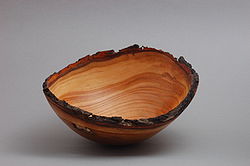


Items made on the lathe include tool handles, candlesticks, egg cups, knobs, lamps, rolling pins, cylindrical boxes, Christmas ornaments, bodkins, knitting needles, needle cases, thimbles, pens, chessmen, spinning tops; legs, spindles, and pegs for furniture; balusters k and newel posts for architecture; baseball bats, hollow forms such as woodwind musical instruments, urns, sculptures; bowls, platters, and chair seats. Industrial production has replaced many of these products from the traditional turning shop. However, the wood lathe is still used for decentralized production of limited or custom turnings. A skilled turner can produce a wide variety of objects with five or six simple tools. The tools can be reshaped easily for the task at hand.
In many parts of the world, the lathe has been a portable tool that goes to the source of the wood or adapts to temporary workspaces. 21st-century turners restore furniture, continue folk-art traditions, produce custom architectural work, and create fine crafts for galleries. Woodturning appeals to people who like to work with their hands, find pleasure in problem-solving, or enjoy the tactile and visual qualities of wood.
Overview
History
Techniques
Holding devices
Tools
Other techniques
Safety
Notable woodturners
See also
References
Bibliography
External links